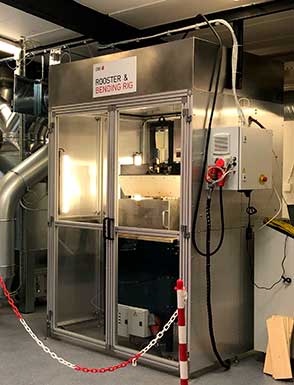Published: 18.10.24
DBI has combined a range of strong expertise to design custom-made fire testing equipment, enabling AkzoNobel to fire-test their own products during the development process. This allows them to get faster and cheaper indications of their products' fire-related properties.
AkzoNobel produces paint and surface treatments for wood. With the growing trend in wooden construction and new fire regulations on the horizon, the company aims to stay ahead of developments and gain greater knowledge of the fire resistance of their products.
“We were immediately very interested when we became aware of some of DBI's testing tools – specifically the mini-SBI and the Electrical Furnace, both of which can be used for scaled-down fire tests during the development phase of new products. In addition to these two tools, we also had a custom-designed bending rig attached to the Electrical Furnace, which can test the strength of the glue on wooden boards," says Niclas Andersson, Senior Application Specialist at AkzoNobel.
"The tools allow us to test products on a smaller scale, providing a quick and affordable indication of how the products perform in terms of fire resistance. This way, we can better understand our own products and test them in combination with our customers' products. This is very important knowledge for both us and our customers," he adds.
"Until now, we had outsourced fire testing to external fire laboratories, but having our own equipment is, of course, much faster and more flexible. At the same time, we build expertise and continuously learn more about our products by being able to conduct ongoing testing during product development. As we are not an accredited fire laboratory, however, our new equipment can only be used for indicative tests, not classification tests," says Niclas Andersson.
AkzoNobel’s testing equipment ended up being quite advanced and unique, as the company had many specific requests.
"We have designed and built testing equipment for a number of companies that want to conduct their own tests during the product development phase. These are always custom solutions tailored to the customer's specific needs. This time, however, there were more requests than we had experienced before, but we managed to find solutions for everything and delivered the testing equipment with all the requested specifications," says Poul Bjerre Toftild, Head of DBI’s subsidiary, DBI Advanced Technologies ApS, which develops testing equipment for construction product manufacturers.
To achieve this, DBI had to bring together a range of different skill sets to develop the highly advanced equipment.
"We had fire experts, electricians, a mechanical engineer, and a data scientist involved. Not only was the equipment designed with numerous safety measures to ensure that AkzoNobel's own staff can safely conduct tests, but it also had to integrate with an advanced ventilation system and fire monitoring," says Robert Firkic, Head of DBI Advanced Fire Testing, and continues:
"It was also a very extensive programming task, resulting in a control system with a high level of safety that continuously provides instructions for various scenarios," he says.
After the delivery and installation of the equipment, DBI will continue to provide support and guidance. As the equipment is DBI's invention and construction, and DBI has many years of experience in conducting fire tests and managing the associated risks, this ongoing collaboration is essential.
"We have received good instruction from DBI, but we are still in a learning process where we need to develop our testing methods. Therefore, ongoing collaboration with DBI is important to us. We are very excited to experiment with the tools and expand the ways we can assist our customers," says Niclas Andersson.
The three specialists who jointly developed the equipment for AkzoNobel are David Norsk, David Lindsay, and Jonas Norsk.

Robert Firkic
Head of Advanced Fire Testing
+45 50 80 78 34
rfi@dbigroup.dk
Photo below:
The Electrical Furnace, can provide an indication of the fire-related properties of products during the development phase.
